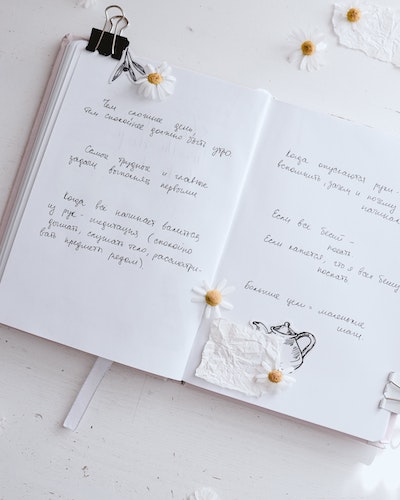
From stream-of-consciousness writing to guided journaling, jotting down what’s inside our heads has the power to make sense of the tangle of ideas in our brains.
I started journaling when I was a teenager and have never really stopped doing it, but the format, the content and the language have changed over the years. And even if improving the languages I was learning was never the goal, in hindsight, I see how this natural practice of recording my days and composing my thoughts had a huge positive impact on my foreign language expression.
Why journaling in the target language (ie. Spanish) works?
Journaling in your target language can be not only a fun practice to track your progress but also a fantastic way to improve and deepen your language knowledge.
Writing encourages insight into your thought processes, behavioural patterns and life experiences. It allows you to look at your point of view and, from this awareness, grow your vocabulary. A vocabulary that is relevant to your own life. It’s personal and significant for you.
Types of journaling for your wellbeing and better language expression
If you are worried about having nothing to write or you fear you wouldn’t know where to start, worry not! I have five different approaches to journaling. Pick your format:
- Daily journaling
This was how it all started for me. Back when I was a little schoolgirl, I would list my daily actions carefully in the first person: Dear diary, today I had breakfast: a Colacao and four biscuits, then I went to school with my mum, on the way, we met with Bea and her mum, then we arrived at school, I had maths, and Pedro had a fist of laughter during…
This journaling style is a great way to start for beginners, both in the art of journaling and the language learning journey.
- Reflective journaling
This is my favourite. Every entry reflects on my life, certain events, emotions, thought processes… It is the natural evolution from the daily journaling style because as you grow, more events call for questioning or understanding, like going from: “Pedro picked on me, and I felt angry because….”. Reflective journaling is the meaning maker, where we make sense of the events of the day or past events that come to mind as we write.
This journaling style is perfect for moving from intermediate to advance in the language learning process as it calls for past tenses and complex sentences.
- Stream of consciousness journaling
Are you not yet acquainted with your thought processes and connections? Then, this journaling style is what you need. Do it in the morning, pen to paper or hands to keyboard, no pause to ponder, no looking back to read what you wrote, no correction or edit…
This is a powerful yet playful way to know your mind and your language level, what is at the front of your mind.
My recommendation is that you start in the target language and switch to your mother tongue or any more immediate language when you need (if you miss words in one language, use another language) because, remember, you can’t stop to think or check the dictionary.
Once you have written for, let’s say, 10 minutes, or until the stream of consciousness dries out, then, yes, look back and see where your gaps in the target expression are. Where couldn’t you express something in the target language? These are your signposts indicating the direction of your language practice.
- Gratitude journaling
Gratitude journaling has carried me through the hardest times of my life and safely placed me on the other, brighter side. Being grateful is good for you! Research tells us that a gratitude practice can help to improve your well-being and happiness. When you combine this practice with your target language, you double the benefits.
Write about all the things you are grateful for. It can be a list of bullet points, or you can write a detailed text about why you are grateful for those things. Either way, your vocabulary won’t be the only thing that improves if you do this.
Ideal for beginners to practice relevant vocabulary about their sphere of life experience and interest.
- Visual journaling, nature journaling and food journaling
You may think that drawing or doodling can’t help your language learning. Think again. Some of us have very vivid mental images when it comes to words. Think “dog”. What does come to mind? Is it an image of a dog, or is the word “dog”?
When you draw about concepts, emotions, life events or daily life while thinking in the target language or using prompts or descriptions in the target language, you are helping your brain to create mental images connected to words in the target language.
Same with nature or food journaling or any other interest you may have.
This type of hybrid journaling, combining words and illustration, is great for any level and absolutely wonderful for advanced levels.
Final notes and recommendations
Of course, if you are not familiar with journaling, I recommend finding some journaling prompts in the target language and targeted grammar points, for example:
✑ 10 journaling prompts to practise Spanish verb + preposition
✑ Use setting intentions to improve your Spanish… and practise the Subjunctive (+journaling prompts)
✑ 10 Journaling Prompts to Practice Ser and Estar in Spanish
Another recommendation is to get journals with prompts to work on specific areas of your life. I particularly like this journal and this one to find inspiration for my journaling sessions. I often translate the questions into my other languages, like French or Spanish.


